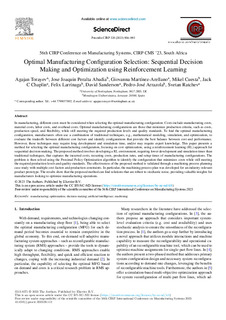Título
Optimal manufacturing configuration selection: sequential decision making and optimization using reinforcement learningAutor-a
Autor-a (de otra institución)
Fecha de publicación
2023Otras instituciones
University of NottinghamVersión
Version publicadaTipo de documento
Contribución a congresoContribución a congresoIdioma
InglésDerechos
© 2023 The AuthorsAcceso
Acceso abiertoVersión de la editorial
https://doi.org/10.1016/j.procir.2023.09.112Publicado en
Procedia CIRP Vol 120. Pp. 986-991. Cape Town, South Africa. 24-26 October, 2023Editorial
ElsevierPalabras clave
manufacturing
optimization
Decision-making
Artificial Intelligence ... [+]
optimization
Decision-making
Artificial Intelligence ... [+]
manufacturing
optimization
Decision-making
Artificial Intelligence
Machining
ODS 9 Industria, innovación e infraestructura [-]
optimization
Decision-making
Artificial Intelligence
Machining
ODS 9 Industria, innovación e infraestructura [-]
Resumen
In manufacturing, different costs must be considered when selecting the optimal manufacturing configuration. Costs include manufacturing costs, material costs, labor costs, and overhead costs. Optimal ... [+]
In manufacturing, different costs must be considered when selecting the optimal manufacturing configuration. Costs include manufacturing costs, material costs, labor costs, and overhead costs. Optimal manufacturing configurations are those that minimize production criteria, such as costs, production speed, and flexibility, while still meeting the required production levels and quality standards. To find the optimal manufacturing configuration, manufacturers often use a combination of traditional techniques, e.g., mathematical modeling, simulation, and optimization, to evaluate the tradeoffs between different cost factors and identify configurations that provide the best balance between cost and performance. However, these techniques may require long development and simulation time, and/or may require expert knowledge. This paper presents a method for selecting the optimal manufacturing configuration, focusing on cost optimization, using a reinforcement learning (RL) approach for sequential decision-making. The proposed method involves developing a RL environment, requiring lower development and simulation times than traditional techniques, that captures the incurred costs, recurring costs, production rates, and setup times of manufacturing configurations. The problem is then solved using the Proximal Policy Optimization algorithm to identify the configuration that minimizes costs while still meeting the required production levels and quality standards. The effectiveness of the proposed method is validated through a machining process planning case study with multiple cost factors and production constraints. In particular, the machining process plan was developed for an industry-relevant product prototype. The results show that the proposed method can find solutions that are robust to stochastic noise, providing valuable insights for manufacturers looking to optimize manufacturing operations. [-]
Colecciones
El ítem tiene asociados los siguientes ficheros de licencia:






















